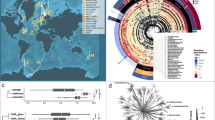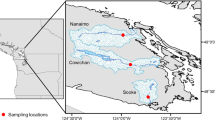Abstract
Microbial communities have a key role in the physiology of the sponge host, and it is therefore essential to understand the stability and specificity of sponge–symbiont associations. Host-specific bacterial associations spanning large geographic distance are widely acknowledged in sponges. However, the full spectrum of specificity remains unclear. In particular, it is not known whether closely related sponges host similar or very different microbiota over wide bathymetric and geographic gradients, and whether specific associations extend to the rare members of the sponge microbiome. Using the ultra-deep Illumina sequencing technology, we conducted a comparison of sponge bacterial communities in seven closely related Hexadella species with a well-resolved host phylogeny, as well as of a distantly related sponge Mycale. These samples spanned unprecedentedly large bathymetric (15–960 m) gradients and varying European locations. In addition, this study included a bacterial community analysis of the local background seawater for both Mycale and the widespread deep-sea taxa Hexadella cf. dedritifera. We observed a striking diversity of microbes associated with the sponges, spanning 47 bacterial phyla. The data did not reveal any Hexadella microbiota co-speciation pattern, but confirmed sponge-specific and species-specific host–bacteria associations, even within extremely low abundant taxa. Oligotyping analysis also revealed differential enrichment preferences of closely related Nitrospira members in closely related sponges species. Overall, these results demonstrate highly diverse, remarkably specific and stable sponge–bacteria associations that extend to members of the rare biosphere at a very fine phylogenetic scale, over significant geographic and bathymetric gradients.
Similar content being viewed by others
Log in or create a free account to read this content
Gain free access to this article, as well as selected content from this journal and more on nature.com
or
References
Cairns SD . (2007). Deep-water corals: an overview with special reference to diversity and distribution of deep-water scleractinian corals. Bull Mar Sci 81: 311–322.
Caporaso JG, Kuczynski J, Stombaugh J, Bittinger K, Bushman FD, Costello EK et al. (2010). QIIME allows analysis of high-throughput community sequencing data. Nat Methods 7: 335–336.
Cebrian E, Uriz MJ, Garrabou J, Ballesteros E . (2011). Sponge mass mortalities in a warming Mediterranean Sea: are cyanobacteria-harboring species worse off? PLoS One 6: e20211.
Edgar RC . (2010). Search and clustering orders of magnitude faster than BLAST. Bioinformatics 26: 2460–2461.
Eren AM, Maignien L, Sul WJ, Murphy LG, Grim SL, Morrison HG et al. (2013a). Oligotyping: differentiating between closely related microbial taxa using 16S rRNA gene data. Methods Ecol Evol 4: 1111–1119.
Eren AM, Vineis JH, Morrison HG, Sogin ML . (2013b). A filtering method to generate high quality short reads using Illumina paired-end technology. PLoS One 8: e66643.
Eren AM, Zozaya M, Taylor CM, Dowd SE, Martin DH, Ferris MJ . (2011). Exploring the diversity of Gardnerella vaginalis in the genitourinary tract microbiota of monogamous couples through subtle nucleotide variation. PLoS One 6: e26732.
Erwin PM, Olson JB, Thacker RW . (2011). Phylogenetic diversity, host-specificity and community profiling of sponge-associated bacteria in the northern Gulf of Mexico. PLoS One 6: e26806.
Erwin PM, Pita L, López-Legentil S, Turon X . (2012). Stability of sponge-associated bacteria over large seasonal shifts in temperature and irradiance. Appl Environ Microbiol 78: 7358–7368.
Gootenberg DB, Turnbaugh PJ . (2011). Companion animals symposium: humanized animal models of the microbiome. J Anim Sci 89: 1531–1537.
Hentschel U, Horn M, Friedrich AB, Wagner M, Moore BS . (2002). Molecular evidence for a uniform microbial community in sponges from different oceans. Appl Environ Microbiol 68: 4431–4440.
Hentschel U, Piel J, Degnan SM, Taylor MW . (2012). Genomic insights into the marine sponge microbiome. Nat Rev Microbiol 10: 641–654.
Hentschel U, Usher KM, Taylor MW . (2006). Marine sponges as microbial fermenters. FEMS Microbiol Ecol 55: 167–177.
Hoffmann F, Radax R, Woebken D, Holtappels M, Lavik G, Rapp HT et al. (2009). Complex nitrogen cycling in the sponge Geodia barretti. Environ Microbiol 11: 2228–2243.
Huse SM, Dethlefsen L, Ja Huber, Mark Welch D, Welch DM, Relman Da et al. (2008). Exploring microbial diversity and taxonomy using SSU rRNA hypervariable tag sequencing. PLoS Genetics 4: e1000255.
Lee OO, Wang Y, Yang J, Lafi FF, Al-Suwailem A, Qian PY . (2011). Pyrosequencing reveals highly diverse and species-specific microbial communities in sponges from the Red Sea. ISME J 5: 650–664.
McFall-Ngai M, Hadfield MG, Bosch TCG, Carey HV, Domazet-Loso T, Douglas AE et al. (2013). Animals in a bacterial world, a new imperative for the life sciences. Proc Natl Acad Sci USA 110: 3229–3236.
Proctor LM . (2011). The Human Microbiome Project in 2011 and beyond. Cell Host Microbe 10: 287–291.
Quast C, Pruesse E, Yilmaz P, Gerken J, Schweer T, Yarza P et al. (2013). The SILVA ribosomal RNA gene database project: improved data processing and web-based tools. Nucl Acids Res 41: D590–D596.
Radax R, Hoffmann F, Rapp HT, Leininger S, Schleper C . (2012). Ammonia-oxidizing archaea as main drivers of nitrification in cold-water sponges. Environ Microbiol 14: 909–923.
Reveillaud J, Allewaert C, Pérez T, Vacelet J, Banaigs B, Vanreusel A . (2012). Relevance of an integrative approach for taxonomic revision in sponge taxa: case study of the shallow-water Atlanto-Mediterranean Hexadella species (Porifera:Ianthellidae:Verongida). Invertebr Syst 26: 230–248.
Reveillaud J, Remerie T, van Soest R, Erpenbeck D, Cárdenas P, Derycke S et al. (2010). Species boundaries and phylogenetic relationships between Atlanto-Mediterranean shallow-water and deep-sea coral associated Hexadella species (Porifera, Ianthellidae). Mol Phylogenet Evol 56: 104–114.
Roberts JM, Wheeler AJ, Freiwald A . (2006). Reefs of the deep: the biology and geology of cold-water coral ecosystems. Science 312: 543–547.
Schmitt S, Tsai P, Bell J, Fromont J, Ilan M, Lindquist N et al. (2012). Assessing the complex sponge microbiota: core, variable and species-specific bacterial communities in marine sponges. ISME J 6: 564–576.
Schröder-Ritzrau A, Freiwald A, Mangini A . (2005). U/Th dating of deep-water corals from the eastern North Atlantic and the western Mediterranean Sea. In: Freiwald A, Roberts JM (eds) Cold-Water Corals and Ecosystems. Springer: Heidelberg, Germany, pp 157–172.
Schöttner S, Hoffmann F, Cárdenas P, Rapp HT, Boetius A, Ramette A . (2013). Relationships between host phylogeny, host type and bacterial community diversity in cold-water coral reef sponges. PLoS One 8: e55505.
Segata N, Izard J, Waldron L, Gevers D, Miropolsky L, Garrett WS et al. (2011). Metagenomic biomarker discovery and explanation. Genome Biol 12: R60.
Selvin J, Shanmugha PS, Seghal KG, Thangavelu T, Sapna BN . (2009). Sponge-associated marine bacteria as indicators of heavy metal pollution. Microbiol Res 164: 352–363.
Simister RL, Schmitt S, Taylor MW . (2011). Evaluating methods for the preservation and extraction of DNA and RNA for analysis of microbial communities in marine sponges. J Exp Mar Biol Ecol 397: 38–43.
Taylor MW, Radax R, Steger D, Wagner M . (2007a). Sponge-associated microorganisms: evolution, ecology, and biotechnological potential. Microb Mol Biol Rev 71: 295–347.
Taylor MW, Thacker RW, Hentschel U . (2007b). Evolutionary insights from sponges. Science 316: 1854–1855.
Taylor MW, Tsai P, Simister RL, Deines P, Botte E, Ericson G et al. (2012). ‘Sponge-specific’ bacteria are widespread (but rare) in diverse marine environments. ISME J 7: 438–443.
Thacker W, Starnes S . (2003). Host specificity of the symbiotic cyanobacterium Oscillatoria spongeliae in marine sponges, Dysidea spp. Mar Biol 142: 643–648.
Thomas T, Rusch D, DeMaere MZ, Yung PY, Lewis M, Halpern A et al. (2010). Functional genomic signatures of sponge bacteria reveal unique and shared features of symbiosis. ISME J 4: 1557–1567.
Webster NS, Cobb RE, Negri AP . (2008). Temperature thresholds for bacterial symbiosis with a sponge. ISME J 2: 830–842.
Webster NS, Taylor MW, Behnam F, Lücker S, Rattei T, Whalan S et al. (2010). Deep sequencing reveals exceptional diversity and modes of transmission for bacterial sponge symbionts. Environ Microbiol 12: 2070–2082.
Webster NS, Taylor MW . (2012). Marine sponges and their microbial symbionts: love and other relationships. Environ Microbiol 14: 335–346.
Webster NS, Webb RI, Ridd MJ, Hill RT, Negri AP . (2001). The effects of copper on the microbial community of a coral reef sponge. Environ Microbiol 3: 19–31.
Acknowledgements
We thank the captains and crew of R/Vs Belgica, Pelagia, Pourquoi Pas?, G.O. Sars, Polarstern and Minibex. We thank Rob van Soest, Thierry Perez, Jean Vacelet and Joana Xavier for providing samples; Sophie Arnaud-Haonlt, Olivier Mouchel, Valérie Cueff-Gauchard and Inge van den Beld for logistic assistance in collecting and shipping samples; Nicola Segata and Sheri Simmons for helpful discussions on LEfSe analysis; Hilary Morrison, Joseph Vineis, and Sharon Grim for assistance with sequencing; Richard Fox for support with the use of MBL super-computers; Nuria Fernandez and Christopher Algar for guidance with R scripts. Two anonymous reviewers are acknowledged for constructive comments, which significantly improved the earlier drafts of the manuscript. Funding was provided by the European Community’s Seventh Framework Programme (FP7/2007–2013) under the HERMIONE project, grant agreement No. 226354.
Author information
Authors and Affiliations
Corresponding author
Ethics declarations
Competing interests
The authors declare no conflict of interest.
Additional information
Supplementary Information accompanies this paper on The ISME Journal website
Supplementary information
Rights and permissions
About this article
Cite this article
Reveillaud, J., Maignien, L., Eren, A. et al. Host-specificity among abundant and rare taxa in the sponge microbiome. ISME J 8, 1198–1209 (2014). https://doi.org/10.1038/ismej.2013.227
Received:
Revised:
Accepted:
Published:
Issue date:
DOI: https://doi.org/10.1038/ismej.2013.227
Keywords
This article is cited by
-
Sponges and their prokaryotic communities sampled from a remote karst ecosystem
Marine Biodiversity (2024)
-
Future ocean conditions induce necrosis, microbial dysbiosis and nutrient cycling imbalance in the reef sponge Stylissa flabelliformis
ISME Communications (2023)
-
New Negombata species discovered: latrunculin mystery solved
Coral Reefs (2023)
-
Oceanographic setting influences the prokaryotic community and metabolome in deep-sea sponges
Scientific Reports (2022)
-
Unravelling the interplay of ecological processes structuring the bacterial rare biosphere
ISME Communications (2022)



